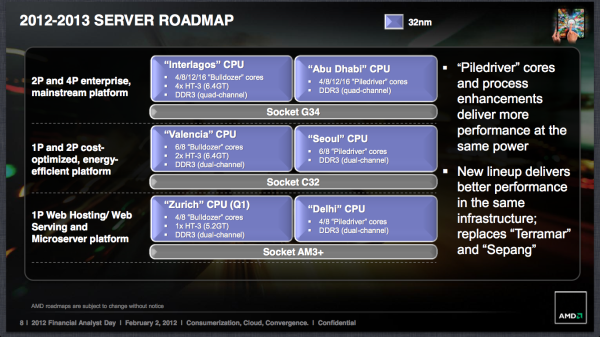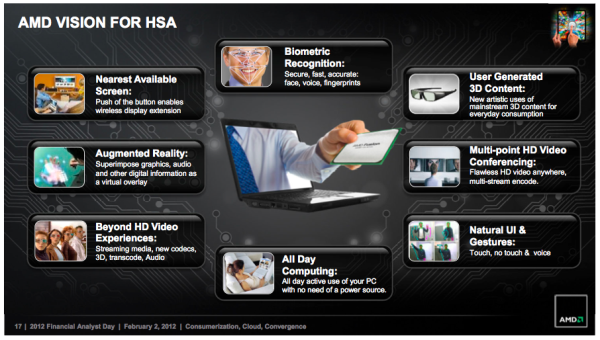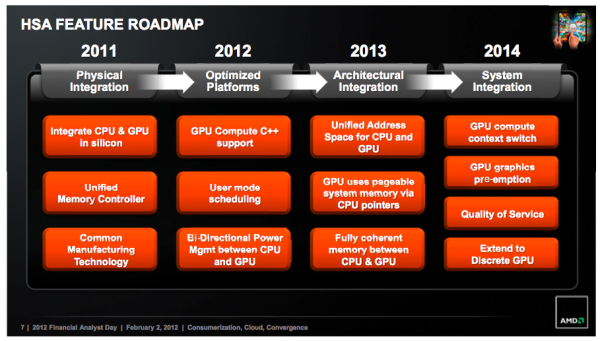Understanding AMD's Roadmap & New Direction
by Anand Lal Shimpi on February 2, 2012 6:16 PM EST- Posted in
- CPUs
- AMD
- Trade Shows
- AMD FAD 2012
The New Focus: Client Mobility
For years we had asked for lower power AMD mobile solutions. While we finally started seeing some progress over the past couple of years, AMD is now very committed to building mobile devices. Anything tablet sized or above is now AMD's target for client APUs.
AMD was always the high-end x86 CPU alternative to Intel in the PC space, now AMD is going to be the alternative in the ultra mobile space.
Servers & the High End Desktop
AMD's server roadmap for the next two years is a bit more conservative. We'll see Piledriver updates from top to bottom but there's no significant departure from the way things are done today. There are no plans for any new sockets in the near term, just using existing platforms to grow AMD's server marketshare without huge new investments.
As AMD's client strategy is predominantly built around APUs, the only high-end desktop parts we'll see from AMD are low-end server CPUs. Socket-AM3+ has a future for one more generation and we'll likely see other single-socket, high-end platforms for the desktop. The days of AMD chasing Intel for the high-end desktop market are done though. That war is officially over.
The Ace: HSA
AMD isn't going to have the fastest general purpose x86 CPUs on the market and it is no longer interested in pursuing that goal. It does promise to have much better on-die GPU performance than Intel. For users today that's primarily an advantage in 3D gaming. As more workloads shift to the GPU however, AMD could have a significant advantage here. The problem is that seamlessly scheduling client workloads across CPUs and GPUs just hasn't happened, the two islands of compute horsepower have remained discrete - even on the new wave of integrated APUs.
AMD's Heterogenous Systems Architecture (HSA) plans to change that. AMD wants to see the creation of a virtual ISA that will be the backbone of a software layer that can schedule application workloads on any combination of underlying CPU/GPU hardware, regardless of the ISA of the hardware. If you have a workload that's best run on big, general purpose x86 cores, that's where it will run. If a task is better designed for highly parallel GPUs cores, it'll run there. And presumably if you had an ARM core somewhere underneath and the workload would run better on it, you'd be covered as well.
AMD plans on delivering an HSA enabled GPU family by 2014, with today's Graphics Core Next GPUs being an intermediary step that already fill a number of these goals. These HSA GPUs would be able to share the same memory space as CPUs and work seamlessly as coprocessors. Granted AMD doesn't have the best track record of quickly moving the industry with things like HSA (although AMD64 did work out quite well), so we'll have to wait and see how all of this plays out.
If AMD can get broad industry support for HSA then its APUs become much more attractive. The overall performance of AMD solutions would then become more compelling as they'd take both CPU and GPU architectures into account, again assuming the workloads require both.













84 Comments
View All Comments
spidey81 - Thursday, February 2, 2012 - link
With AMD's focus going the direction of mobile/AIO or server parts will the consumer market ever see anything directed at the desktop enthusiast marker? I guess I'm still hopeful to see a trickle down from the server marker or desktop innovation trickling down to the mobile sector as has been in the past. Maybe it's just time to jump ship to intel for my next gaming/oc rig.arjuna1 - Thursday, February 2, 2012 - link
You ninja'd my post, but, exactly the same feeling, but you know what?? if they dare to give me the middle I will give them the middle finger, no problem in making my next build intel/nvidiaspidey81 - Thursday, February 2, 2012 - link
I just upgraded from a PII X3 720 to an FX8120. It's frustrating to know that even with it clocked at 4.5Ghz I'm still not going to get the performance I would have with a 2500K. I've never built with anything other than AMD and really don't plan on changing that. However, It's getting increasingly difficult to support them.just4U - Thursday, February 2, 2012 - link
Hey Spidey.. your not missing to to much. I've built several i5/i7 setups and use one everyday. But I've also picked up an FX6100 and it's pretty good to. I don't mind switching back and forth and while there may be a slow down in some games .. some apps.. I don't notice it unless I am actually looking at the numbers. They all seem fast overall.Sabresiberian - Thursday, February 2, 2012 - link
My experience is different. I have built 2 computers, one on the i7 920 and one on the Phenom II 955. The difference is clear and significant playing World of Warcraft, and any other MMORPG.My experience is mirrored by Anandtech and Tomshardware benchmarks.
Now, if you aren't a person that actually uses all the performance he can get, the Phenom II is fine, but even having been an AMD fan for years, I won't go back and cut my nose off to spite my face, as they say.
AMD has chosen a different path than I would like for them to have, but I'm not going to fault them for it. I'm disappointed as an enthusiast builder, but I certainly recognize there is a far wider market than CPUs for people like me. However, it also means they no longer are interested in supplying what I want, so we must part ways.
;)
Spoelie - Friday, February 3, 2012 - link
Have been an AMD/ATI loyalist for a long time, and have only built AMD/ATI setups *for my personal use*. But I always only upgraded to a product that was either very competitive (Tbird, A64, X2, PhII early on) or dirt cheap and very overclockable (Tbred, Barton for example) - holding out the times AMD wasn't very competitive (kept my X2 pretty long, skipped PhI).The thing is that my 3 year old DDR2 Deneb@3.3ghz has never felt inadequate at all, helped by an SSD and yearly GPU upgrades.
When the time comes however, I'll have no qualms switching to Intel's latest and greatest, in the same spirit as Sabresiberian
wumpus - Wednesday, June 27, 2012 - link
>The difference is clear and significant playing World of Warcraft, and any other MMORPG.WoW was released in something like 2007. I very much doubt a modern CPU would notice the difference (I used to play Dungeons and Dragons online (2008) with a 2GHz Sempy, and it ran just fine). Methinks you have different GPUs and that might just make the difference (WoW used to be famous for not stressing the GPU, I doubt they have changed it).
Still, as someone who has always liked AMD more than Intel, I suspect I will wind up buying more Intel processors in the future (the fact that every single Intel processor I've bought has been deliberately crippled annoys the bejesus out of me).
Face it, the desktop is "dying" (read becoming a mature tech that doesn't obsolete itself every Thursday). Don't expect every high tech company to want to swoop down and grab a piece of the pie anymore. Intel will have a hard enough time with every "tock" competing with the previous "tick".
GotThumbs - Friday, February 3, 2012 - link
I think one of the key factors your leaving out...Is what is the cost/price difference. I've built all AMD systems since my first Pentium II build, and been quite happy with the system and the performance I've gotten, while still having some cash left in my pockets. I'm even looking at down-sizing my system to an APU on an ITX board with an SSD. Today's CPU's meet probably 95% of the markets needs. It's only a select few who need hard-core performance on an hourly basis and can justify spending huge amounts of money to have a high-powered system. Higher CPU speeds is not the only focus in today's market. Battery life and user experience is what matters. If you can get the same experience with a lower speed processor...then whay pay more....bragging rights only takes you so far.I think AMD has matured and is no longer concerned with competing with Intel on having the biggest and baddest CPU's. Most general consumers barely use 1/3 the capacity of their systems.
bill4 - Thursday, February 2, 2012 - link
Its funny how people hate AMD so much they automatically push this "AMD is getting out of the high end!" agenda in post along the internet. It's not commentary, it's your hope.Nvidia is the only one getting out of the high end since they dont even have a competitor to Tahiti.
Amd Bulldozer was definitely a play at the high end, it's a huge ambitious chip, it just sucks.
Get your head out of your ass Nvidia fanboys, AMD is not going anywhere no matter how hard you wish it/
arjuna1 - Thursday, February 2, 2012 - link
Hey bill, I've been building AMD/ATI since the K6/9800, why don't you just stfu, learn to read before opening your mouth.